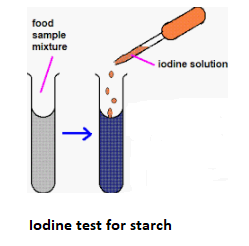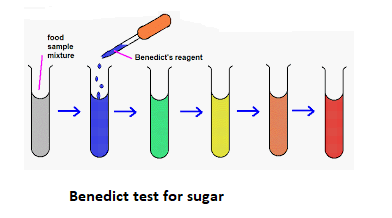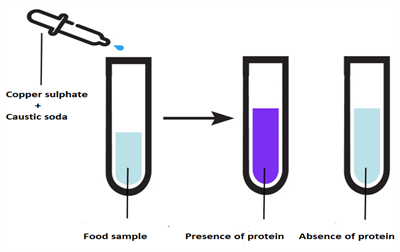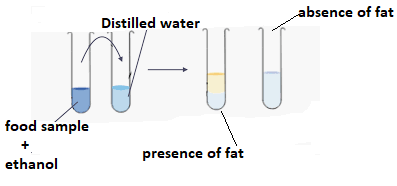
PUMPA - SMART LEARNING
எங்கள் ஆசிரியர்களுடன் 1-ஆன்-1 ஆலோசனை நேரத்தைப் பெறுங்கள். டாப்பர் ஆவதற்கு நாங்கள் பயிற்சி அளிப்போம்
Book Free DemoAs we have discussed earlier, different food items contain various nutrients in different amounts. The presence of these nutrients in the food (both raw and cooked) can be tested using some tests, among which the tests for carbohydrates, proteins and fats are some of the simple ones and are discussed below.
Following are the different tests for the confirmation of nutrients in the food items.
Test for Starch:
- Add 2-3 drops of iodine solution (prepared by adding a few drops of tincture iodine to a test-tube half filled with water) to it.
- Observe the change of colour of the food item.
Observation:
The appearance of the blue-black colour indicates the presence of starch in the tested food item.
Inference:
Iodine that was added to the food reacts with the starch present in it. This forms a Starch-Iodine complex that is blue-black. Thus, the appearance of colour change to blue-black colour confirms the presence of starch in the food item.
Blue-black colour indicates the presence of starch in the tested food item.

A video that explains the test for starch in various food items - potato, rice, salt, and sugar is attached below:
Test for sugar:
Benedict's test:
Benedict's solution is a clear blue solution of sodium and copper salts used to test for simple sugars, such as glucose.
The blue solution turns orange, yellow, or brick-red in the presence of simple sugars, depending on the amount of sugar.

Test for protein:
- Take a small quantity of food item and either make a paste or powder of it.
- Put some of it in a test tube, add 10 drops of water and shake the test tube.
- Using a dropper add a two drops of copper sulphate solution and 10 drops of caustic soda solution to the test tube.
- Shake the tube well and observe the change of colour of the food item.
Important!
Copper sulphate solution is prepared by dissolving \(2g\) of copper sulphate in \(100ml\) of water and caustic soda solution is prepared by dissolving \(10g\) of caustic soda in \(100ml\) of water.
Observation:
The sample of the food turns violet or purple in colour.
Inference:
The change in colour to purple or violet confirms the presence of protein in the food.

The video below displays a test for protein in milk and salt solution:
Test for fats:
It is a very simple test.
- Crush the food inside a tissue paper and shake or crush the food to make it dissolve.
- Now straighten the paper and observe it carefully.
- An oily patch can be found.
- This patch indicates the presence of fat in the food.
Observation:
The paper turns translucent and becomes greasy.
Inference:
The given food sample contains fat.
The video below displays the test for fat:
Second test for fats:
- Filter or dilute the food and mix it with ethanol to make a clear liquid (a solution of fat in ethanol).
- Pour this into a test tube filled with water.
- The presence of fats or oils is indicated by a white (milk-like) emulsion.
A white (milk-like) emulsion indicates the presence of fats or oils.

The nutrients such as carbohydrates, proteins, vitamins, minerals, fats are highly essential to make a person healthy and make a balanced meal. These are the major nutrients of a meal. In addition to these, we also need dietary fibres and water to make the absorption of all the nutrients easier.
Reference:
http://www.docbrown.info/ebiology/foodtests.htm .copyrighted image.
http://www.docbrown.info/ebiology/foodtests.htm .copyrighted image
https://www.tuttee.co/blog/biol-biological-molecules-carbohydrates-proteins-and-lipids. copyrighted image
https://socratic.org/questions/what-should-you-use-to-test-if-a-type-of-food-has-starch-sugar-or-fat . copyrighted image